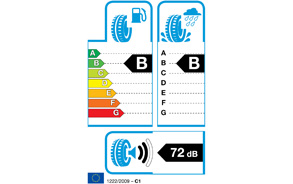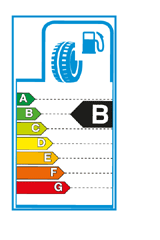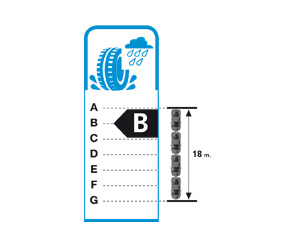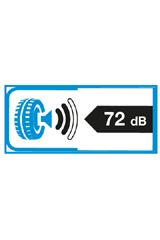New EU tyre labelling: what does in mean for me?

Tyre labelling for passenger cars and light trucks will take effect from 1 November 2012 under European Regulation (EC) No. 1222/2009.
This new regulation will bring a major advance in consumer information on tyre safety(wet braking) and the tyre’s impact on the environment (rolling resistance and external noise).
The graphics on the label may be familiar as they are already used for household appliances
and more recently for new cars, but what are the benefits for consumers?

Compare fuel economy

Use this diagram to see how a tyre performs on fuel consumption.
Fuel-efficiency is graded from A (most efficient) to G (least efficient).
Save up to £110 or 80 litres of fuel over the life of the tyres. That’s for a car fitted with four A-rated tyres driving at 50mph – it uses 7.5% less fuel than with G-rated tyres.
Results can vary with type of car or climatic conditions but the performance gaps are proven.
Compare braking on wet roads
This chart grades a tyre on how well it brakes in wet conditions. Performance scales from A (the safest, stopping in the shortest distances) down to G (least safe, with longest braking distances).
Stop up to 4 car lengths shorter. For a car fitted with four A-rated tyres driving at 50 mph, stopping distance can be up to 18 metres or 30% shorter than with G-rated tyres.

Compare external noise level
This diagram shows you a tyre’s noise level in decibels (dB). The 3-wave pictogram tells you how it rates in relation to future European mandatory limits. Tyre noise heard outside the car doesn’t necessarily relate to what you hear inside the car.
3 black waves = Noisier tyre. Level greater than the future limit but complies with today’s noise regulation
2 black waves = Average tyre. Noise level equal to or below future limit by up to 3 dB (A)
1 black wave = Low noise tyre. Noise level 3 dB (A) or more below future noise limit
3dB doesn’t sound much but it is actually double the noise level!

Tyre Background
Tyres have to cope with the considerable forces generated by accelerating, braking and cornering, while helping to insulate the
cars occupants from road surface irregularities.
We expect them to provide good grip, have low road noise and have a good lifespan.
In addition to all of this, we expect the humble tyre to do this in all types of weather……. all in all, a fairly tall order!
In recent years, modern tyres are almost always of radial construction, the trend being to wider and lower tyres, with most cars having
power-steering. Without power-steering, the road contact area of wide, low-profile tyres would make the steering effort excessive,
making turning very difficult and requiring arms of steel to turn the steering wheel in any direction at low speed.
A few things you should know about tyres !
Choosing the right tyres for your vehicle is very much horses for courses, at Walkers we will be able to advise you which tyre best
suits your vehicle as we will consider what type of car you drive, what sort of roads you use your vehicle on and what you want
or expect from a tyre….. we can work within financial constrains , but safety is our up most priority.
How can I tell if the tyre has a safe amount of tread on it ?
The primary purpose of the tyre tread is to allow the tyre to provide grip on a surface that is wet, unless the tyre is designed for racing
on a dry racing track which requires a smooth tyre surface. At 100km/h, on a wet road, an average tyre has to move more than five
litres of water a second from the tyre/road contact patch – that is where the tyre touches the road surface.
To displace this water the tyre surface has grooves moulded into it. It is very important that tyres have enough tread to
maintain grip in wet conditions.
The minimum legal tread depth is 1.6mm across three-quarters of the tyre width and around the entire circumference.
Modern tyres usually have a wear strip set in the central grooves. When the tread is worn down to this strip, the tyre is
at minimum tread depth and should be replaced, immediately .. if you are unsure if your tyres are legal, we are here to help.
Does it matter if the tyre is a bit soft or slightly deflated ?
It is very important that the manufacturer’s recommended tyre pressures are used and maintained.
If the pressure is too low or too high the tyre may overheat, wear rapidly and it will affect handling …. see guide below
Is there anything else I should be looking for ?
An occasional check of the tyre sidewalls will pick up any damage caused by stones or road debris.
Also look for uneven wear of the tread i.e. wearing on one side. This can indicate wheel-alignment or suspension problems.
What do those numbers on the side of the tyres mean ?
Tyre size: For cars, usually expressed as width in millimetres i.e. 195 is 195 millimetres measured across the width.
Tyre construction: The vast majority of tyres on cars and 4×4’s are of radial construction symbolized by R.
Absence of a letter means the tyre is of cross ply construction. It is possible this may also be the case on some vintage or classic cars.
Aspect ratio: Have you heard people talk about low profile tyres? This refers to the ratio of width to height of the tyre.
Speed performance rating: Expressed as a letter for maximum designed speed, L is 160km/h, S is 175km/h, H is 210km/h
and V is above 210km/h.
Wheel-rim diameter: Usually expressed in inches e.g. 14 inches.
Example: 195/70 R14 91H means Tyre width is 195mm, Profile is 70, Radial construction, rim size is 14 inch and spxeed rating is
for a maximum speed of 210km/h.
If you have any further questions about your tyres, or maybe you need some advice or help, pop in or give us a call.

